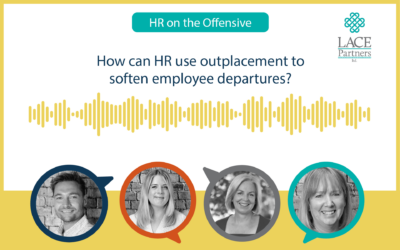Research from the likes of McKinsey and Harvard Business School consistently cite the failure rate of business transformations at around 70-75%. That’s pretty huge. Aaron Alburey from our team digs into the reasons why and explains how HR is essential to get people’s buy-in to any transformation.
No matter how impressive the tech, how far-reaching the aspiration or how good the leadership, the fact is that most business transformations fail.
Any complex change in the workplace is not just about the mechanics of the change itself – it’s about the emotional connection that people in the workplace have with it. That’s the ‘buy in’ that business leaders should – but often don’t – prioritise as part of their transformation plans.
What does ‘employee buy in’ actually mean?
Any form of business transformation expects employees to take on a whole new way of working. That’s a given. But it’s also the key part of the transformation puzzle that the leadership tend to overlook. So, what if it doesn’t happen? And whose job is it to get that buy in anyway?
While there can be a sort of forced momentum generated by the leadership in the early stages of a transformation, this will rarely outlast the initial burst of enthusiasm. Without HR taking control of the narrative and communicating exactly why this change is important, why it’s happening and why they should care, employee enthusiasm tends to fade away.
People either don’t see a reason for them to invest the time and energy in the behavioural changes necessary to achieve transformation, or they don’t care enough to be part of the collective behavioural shift that needs to happen.
With no reinforcement or top-level understanding of the employee skills necessary, then employees will just naturally revert back to the old way of doing things. This leaves the project to level out with either nothing achieved or at half way to the goal.
Key steps are often skipped by leadership teams
Companies frequently neglect a key step towards transformation – the people. Either the wrong people are driving the transformation or those that have been tasked with the job don’t have enough time to dedicate to it. And on top of that, the necessary collective behavioural shift doesn’t happen, because the right kind of communication is weak or non-existent.
Leading any kind of transformation rests on successfully getting your people to buy in to your strategy. And yet this is the step that so many businesses fail to include in their long-term approach to business transformation.
Often, there’s an expectation that employees will automatically fall in behind the change and surprise when they don’t. Leading business transformational change is complex and the most important factor in its success is whether the people involved understand or, crucially, believe in the changes.
What does ‘buy in’ look like?
Getting employee buy in to something new and unfamiliar isn’t a simple task. Think of successful buy in as the point at which different facets align:
- Employees are committed to, and fully understand, the overarching goals of the company
- Employees have a clear understanding of the business leadership’s strategy and vision
- Employees understand how they are involved in driving this change and what their roles will contribute towards it
- Employees emotionally and logically believe that the transformation will not only improve the company itself, but also customers and themselves.
In short, leadership needs to think about employees asking them: “What’s in it for me?”, rather than simply falling into line unquestioningly.
Why HR will ask – and answer – the right questions
Belief is perhaps the most important – most nebulous and unpredictable – contributor towards successful change. Energy and enthusiasm are cultivated through a shared belief in the positive. On the flipside, however, if employees feel threatened by the planned transformation, or that the project itself is weak, then it will fail.
These factors contribute to any transformative project, whether it’s to switch to new technology or a total rebrand of the company values.
The real hub of successful business transformation is listening to people’s questions. They want to know: why is this good for me? What will it do for me? Why should I change my working behaviour?
And this is where HR comes in. By aligning the business change strategy with the HR-driven people strategy, businesses are far more likely to get what they want.
HR is in a better position than the leadership team to find out and unpack why and when the employees will be ready and willing to change. There is a significant role for HR here in developing change readiness in the employees in a useful way.
HR’s specific insight into the workforce and the culture of the business is unique, and this will inform the communication back to the employees, to answer their questions and mitigate perceived risk.
For each group of people – or employee persona – HR can understand the risks that the employees see and help to inform and communicate effectively.
Communicating the change – how HR can pave the way
The kinds of risks that employees perceive when significant transformational change is looming vary but tend to have similar themes.
Fear can hold back change, and this is what drives resistance in many cases. Employees want to know what the proposed change means for them. For example, they might ask “Does this make my life easier? Does it make my job easier? Will I have to learn something new and am I even capable of doing so?
By addressing the risks expressed by employees, HR can get to a much stronger level of mutual support. This is when there is a significant culture shift and a move towards being open and willing to make the behavioural changes necessary.
They will understand why this is the right thing to do, because HR will have utilised its skills to get employees fully on board by explaining:
- Why the transformation is happening
- What it will look like in the future
- The steps that the company will take to get there
- What the employee’s individual role is in achieving successful transformation.
HR and management should work together to drive successful transformation
With this kind of framework in place and managed by HR departments or consultants, the management team is also reassured. Their personal risk is reduced, and this builds a strong foundation for meaningful change across the entire organisation.
HR and the leadership or management team working together are far more likely to achieve the kind of buy in that will drive the transformation and sustain it in the long term.
A proactive approach towards engaging employees right at the start, not in a top-down or coercive way, but in a meaningful and useful way, is the missing piece of the business transformation puzzle for organisations.
If you’d like to talk to us about your transformation project, reach out to us using the form below.









